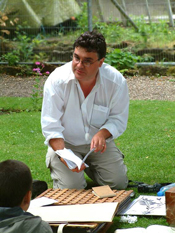Dr Fred Rumsey
A passion for observing the natural world had led our UK plant expert to root out rare plants and help endangered species around the nation.

Early aspirations
Dr Rumsey enjoys the subtlety of plants, appreciating that they are not as obviously cute as animals. He particularly likes the small plants that people don’t usually notice, and enjoys the challenge of finding them in new areas, or re-finding them when believed lost.
He gets a warm glow discovering something new, and enjoyed one of his first experiences of real discovery on an undergraduate field trip during his botany degree. On the island of Majorca he collected a new parasitic plant species that was subsequently named after him.
Super specimens
The Killarney fern has been special to Dr Rumsey since he studied it for his PhD. Not only did he meet his wife while researching its habitats, he also discovered this species in many more places around the UK. The ‘exotic, tropical-looking’ fern needs very humid environments to thrive in. Thanks to a unique lifecycle, however, it spends much of the time looking like felt, in a state of hibernation, waiting for the next warm, wet period.
‘We thought this plant was staggeringly rare in the UK, but if you look in the right dank holes there it is, just not able to complete its life-cycle,’ said Dr Rumsey.
Preserving life
As well as answering enquiries from the public and scientists about plants and the botany collections, Dr Rumsey carries out research for the Museum and for conservation organisations such as Natural England. He surveys extremely rare plants around the UK and gives recommendations on their conservation.
Through an innovative teaching programme developed with the Cothill Trust, he also works with schoolchildren linking field natural history with molecular approaches.
DNA sequencing has transformed our knowledge of biodiversity, but Dr Rumsey still passionately believes in the simple power of observation. ‘Everyone can contribute to the better understanding of our wildlife even without access to the Museum’s amazing facilities.’